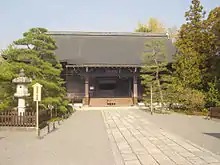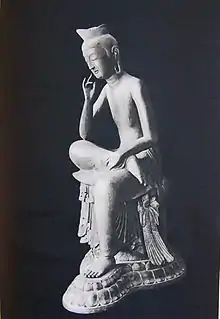
Kōryū-ji (広隆寺) is a Shingon temple in Uzumasa, Ukyō Ward, Kyoto, Japan. The temple is also known by the names Uzumasa-dera (太秦寺)[1] and Kadono-dera (葛野寺), and was formerly known as Hatanokimi-dera (秦公寺), Hachioka-dera (蜂岡寺) and Hōkō-ji (蜂岡寺).
Kōryū-ji is said to be the oldest temple in Kyoto, having been constructed in 603 by Hata no Kawakatsu upon receiving a Buddhist statue from Prince Shōtoku. Fires in 818 and 1150 destroyed the entire temple complex, but it was rebuilt several times since.[2]
Wooden statue of Bodhisattva

The temple contains a number of important pieces of cultural heritage. One of national treasures in Japan (registered on June 9, 1951), a wooden image of the Bodhisattva Maitreya sitting contemplatively in the half-lotus position, called "Hōkan Miroku" (宝冠弥勒) is amongst the rare objects that are preserved and displayed at Kōryū-ji.[2]
The temple is also renowned for its Bull Festival (牛祭, ushi matsuri), traditionally held in mid-October, but currently suspended.[3]
Notes
See also
- Historical Sites of Prince Shōtoku
- List of Buddhist temples in Kyoto
- List of National Treasures of Japan (temples)
- List of National Treasures of Japan (ancient documents)
- List of National Treasures of Japan (sculptures)
- For an explanation of terms concerning Japanese Buddhism, Japanese Buddhist art, and Japanese Buddhist temple architecture, see the Glossary of Japanese Buddhism.